数理经济学ppt课件
- 格式:ppt
- 大小:1.50 MB
- 文档页数:42
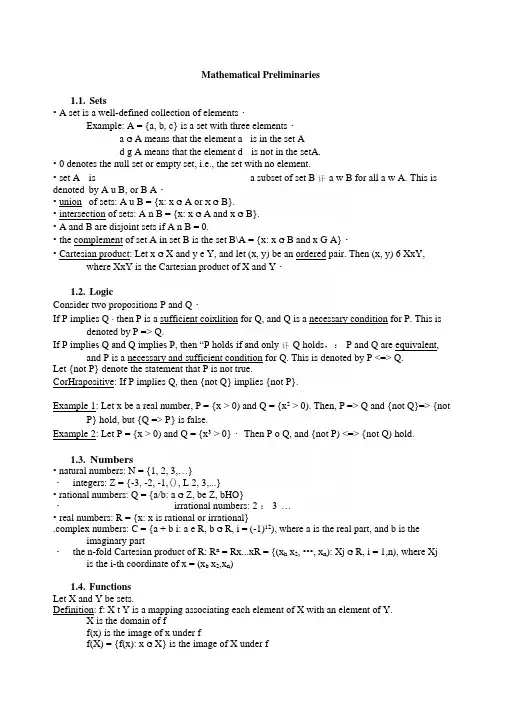
Mathematical Preliminaries1.1.Sets•A set is a well-defined collection of elements・Example: A = {a, b, c} is a set with three elements・a G A means that the element a is in the set Ad g A means that the element d is not in the setA.•0 denotes the null set or empty set, i.e., the set with no element.•set A is a subset of set B 讦a w B for all a w A. This is denoted by A u B, or B A・•union of sets: A u B = {x: x G A or X G B}.•intersection of sets: A n B = {x: x G A and x G B}.•A and B are disjoint sets if A n B = 0.•the complement of set A in set B is the set B\A = {x: x G B and x G A}・•Cartesian product: Let x G X and y e Y, and let (x, y) be an ordered pair. Then (x, y) 6 XxY, where XxY is the Cartesian product of X and Y・1.2.LogicConsider two propositions P and Q・If P implies Q、then P is a sufficient coixlition for Q, and Q is a necessary condition for P. This is denoted by P => Q.If P implies Q and Q implies P, then “P holds if and only 讦Q holds,: P and Q are equivalent, and P is a necessary and sufficient condition for Q. This is denoted by P <=> Q.Let {not P} denote the statement that P is not true.CorHrapositive: If P implies Q, then {not Q} implies {not P}.Example 1: Let x be a real number, P = {x > 0) and Q = {x2 > 0). Then, P => Q and {not Q}=> {not P} hold, but {Q => P} is false.Example 2: Let P = {x > 0) and Q = {x3 > 0}・ Then P o Q, and {not P) <=> {not Q) hold.1.3.Numbers•natural numbers: N = {1, 2, 3,…}・integers: Z = {-3, -2, -1,(), L 2, 3,...}•rational numbers: Q = {a/b: a G Z, be Z, bHO}・irrational numbers: 2 : 3 …•real numbers: R = {x: x is rational or irrational}.complex numbers: C = {a + b i: a e R, b G R, i = (-1)12), where a is the real part, and b is the imaginary part・the n-fold Cartesian product of R: R n = Rx...xR = {(x h x2, •••, x n): Xj G R, i = 1,n), where Xj is the i-th coordinate of x = (x b x2,x n)1.4.FunctionsLet X and Y be sets.Definition: f: X t Y is a mapping associating each element of X with an element of Y.X is the domain of ff(x) is the image of x under ff(X) = {f(x): x G X} is the image of X under f•a function: if only one point in Y is associated with each point in X・ a coirespondence: if more than one point in Y can be associated with each point in X •inverse function: x = f *(y) if and only if y = f(x).a function f: X T Y is onto 讦f(X) = Y.It means that the equation f(x) = y has at least one solution for each y.•if f(x) and f ly) are both single・valued, then f is on—to-one.It means that the equation f(x) = y has at most one solution for each y.•composite function: h = g(f(x)) = g • f is the composition of f with g satisfying f: A t B u C, g:C t D, g • f: A t D.L5e BoundsLet S c R.•S is bounded from above (from below)讦there exists a G R (b G R) such that x < a (x > b) for all x G S. Then, a is an upper bound of S, and b is a lower bound of S・•The least upper bound (lub) or suDremum (sup) of S is the upperbound of S such that there does not exist a smaller upper bound. It is denoted by sup(S).•The supremum of S is called a maximum (max) of S if sup(S) G S. It is denoted by max(S). •The greatest lower bound (gib) or infimum (inf) of S is the lower bound of S such that there does not exist a larger lower bound. 1( is denoted by inf(S).•The infimum of S is called a minimum (min) of S if inf(S) e S. It is denoted by min(S).• Property:If S c R and S has an upperbound, then S has a supremum.If S u R and S has a lowerbound, then S has an infimum.16 Vector SpaceConsider a set V.LI- associative law: x + (y + z) = (x + y) + z, for all x, y, z, w VL2- identity: there exists O G V such that x + 0 = x for all x G VL3- inverse: there exists (-x) e V such that x + (-x) = 0 for all x e VL4- commutative law: x + y = y + x for all x, y G VL5- associative law: a・([3・x) = (a-p) x for all a, p e R, and for all x G VL6- identity: there exists 1 G V such that l x = x for all x e VL7- distributive law: a・(x + y) = a x + a y for all ae R, and for all x, y w VL8- distributive law: (a + p)-x = a x + p x for all a,卩G R, and for all x G V L9- closure: x e V and y G V implies that (x + y) G V LIO- closure: x G V and ae R implies that (a・x) e V. Definition: A set V is vector space (or linear space) if it satisfies Ll-Ll0. Then x G V is called a vector. Examples: R l\ or C n is each a vector space.1.7. Norms and distancesConsider a function d(x, y) satisfying:M1: d(x, y) = 0 if and only if x = y M2: d(x, y) + d(y, z) > d(z, x) M3: d(x, y) > 0 for all x, y M4: d(x, y) = d(y, x).Definition: For a given set X,讦a function d: XxX —> R satisfies M1-M4, then: X is a metric space, denoted by (X, d)d is a metricd(x, y) is the distance between points x and y.Examples:di(x,y) = [Zi (xj - yi)2!12 = Euclidian distance,denoted by ||x - y||d2(x, y) = maxi 风-y s|d3(x, y) = Zi lx, - y.lNote: Topology consists in studying the properties of sets that are independent of the distance measure chosen.Definition: Let V be a vector space・ A real value function N: V t R is called a norm on V if: N(x) > 0 for all x G V N(x) = 0 if and only if x = 0N(r x) = |r| N(x) for all re R and x e V, andN(x + y) < N(x) + N(y) for all x, y G V.Example: N(x) = d|(x, 0) = [Xi (xj)2]12 = ||x|| is the Euclidian noim of x in R.R n, with Euclidian norm and Euclidian metric, is a normed vector space.Every normed vector space is a metric space with respect to the induced metric defined by d](x, y) = llx - yll.Convex SetsLet X be a vector space (e.g・,X = R n).Definition: A set S c: X is convex if any x, y G S implies that(0x + (1-0) y) e S, for all 0 e R, 0 < 0 < 1.Note: (0 x + (1-0) y) is called a linear combination of x and y.Properties:・Any intersection of convex sets is convex.•Let Si, i = 1,m, be convex sets in vector space X. Then:•(Ejei (Xj Si) = {x: x = Z i=i■•…m oti Xi, XjG Sj, otf R, i = 1,…,Hi} is a convexset.•(SixS2x...xS m) = x i=1■•…m (Si) is a convex set.L9. Compact SetsLet S u R n.Definition: An open ball about x0 e R n with radius r e R, r > 0, is defined as:B r(x0) = {x: x G S, d(x, x0) < r}, where d(x, x0) is the Euclidian distance betweenpoints x and x0.Definition: An open set S u R n is a set S such that, for each x e S, there exists an open ball B r(x) completely contained in S.• The union of open sets is open..A finite intersection of open sets is open.Definition: The inierior of a set S, denoted by int(S), is the union of all open sets contained in S..A set S is open 讦and only 讦S 二int(S).Definition: A set S c R n is closed 讦the set (R n\S) is open.・The intersection of closed sets is closed・.A finite union of closed sets is closed・Definition: The closure of a set S, denoted by cl(S), is the intersection of all closed sets containing S..A set S is closed if and only if S = cl(S).Definition: The boundary of a set S u R" is the set cl(S)ncl(R n/S).Definition: A set S is bounded if there exists an open ball with a finite radius which contains S・Definition: A collection of open sets (S a)a€A in a metric space X is said to be an open cover of a given set S u R n if S u 低入 S a.The open cover (S a)ae A of S is said to admit a finite subcover if there exists a finitesubcollection (SQ^F such that S u S®Definition 1: A set S c R n is compact if and only if it is closed and bounded・Definition 2: A subset S of a metric space X is compact if and only if every open cover of S has a finite subcover.Note: The definition 2 of compactness applies to sets in any metric space, while definition 1 applies only to sets in R n.LIO. SequencesLet (X, d) be a metric space (e.g., X = R n), and let S c X.Definition: A sequence {xj: j = 1,g} in S converges to y if, for any e > 0, there exists a positive integer j" such that j hj,implies d(y, xj) < e.This is denoted by y = limj* {xj, where y is the limit of {Xj}.Note: It does not follow that y = lirOjT® {xj} G S・Definition: A sequenee {Xj: j = 1,…,g} in S is a Cauchy sequence if for any e > 0, there exists a positive integer such that, for any ij > j\ d(x i9 Xj) < £.Definition: If every Cauchy sequence in a metric space is also a convergent sequence, then the* A sequence {xp j = 1,…严} in R" is a Cauchy sequence if and only if it is a convergent sequence, i.e. if and only if there is y G R n such that linij》{Xj} —> y.metric space is said to be complete.By the above definition, this implies that R n is complete (although not all metric spaces are complete)・Definition: Let m(j) be an increasing function: m: {12 3,…} T {1, 2, 3,such that m(k+l) > m(k).Given a sequence {xj: j = 1, 2,…,g}, {m = 1,…,g} is a subsequence of {xj: j =1,2,…,oo}..A set S c R n is closed if and only if every convergent sequenee of points in S converges to a point in S・・ A set S e R n is compact if and only if every sequence in S has a convergent subsequence whoselimit is in S.・ A sequence {xj: j = 1, 2,…,g} in R n converges to y if and only if every subsequence of {xj: j =1,…,g} converges to y.・Every bounded sequence contains a convergent subsequence・Definition: A sequence {xj: j = 1,2,…,oo} is (strictly) increasing if, for all m > n, x m > (>) x n for all n.A sequence {xj: j = 1,2,…,<»} is (strictly) decreasing if, for all m > n, x m < (<) x n forall n・Let X u R, X H 0. If X is bounded from above (below), there exists an increasing (decreasing) sequence in X converging to sup(X) (inf(X)).Definition: Assume that ±oo are allowed as limits of a sequence.The lim sup of the sequence {xj: j = 1,in R is defined as limj^oo {可:j =1,2 •••}, where aj = sup{xj, Xj+b Xj+2. ...}・ It is denoted by linij^oo supk>j x k, or simply by lim SUpjTco Xj・The lim inf of the sequence {Xj: j = 1,in R is defined as limj^ {bj: j = 1,2 …}, where bj = inf{x jt Xj+i, x i+2, ...}. It is denoted by inf k>j x k, or simply by lim infj†Xj・† A sequence xj in R converges to a limit y G R if and only if y = lim supj* Xj = lim in与* Xj.。



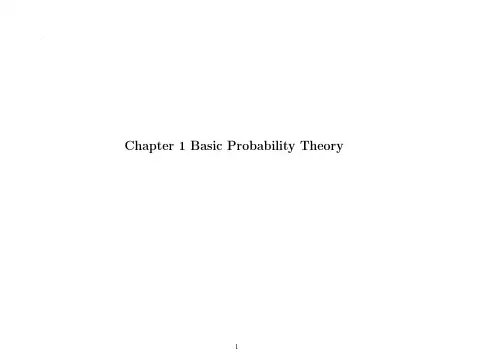
.Chapter1Basic Probability Theory•A random experiment is a process that generates well-defined outcomes. One and only one of the possible experimental outcomes will occur,but there is uncertainty associated with which one will occur.•Fundamental axioms of modern econometrics:–An economic system can be viewed as a random experiment governed by some probability distribution or probability law.–Any economic phenomena(often in form of data)can be viewed as an outcome of this random experiment.•Two essential elements of a random experiment:–The set of all possible outcomes—sample space.–The likelihood with which each outcome will occur—probability func-tion.•Definition:Sample Space.The possible outcomes of the random experiment are called basic outcomes,and the set of all basic outcomes is called the sample space,denoted by S.When an experiment is performed, the realization of the experiment is one outcome in the sample space.•Examples:Finite Sample Space.Experiment Sample SpaceToss a coin{Head,Tail}Roll a die{1,2,3,4,5,6}Play a football game{Win,Lose,Tie}•Example:Infinite Discrete Sample Space.Consider the number of accidents that occur at a given intersection within a month.The sample space is the set of all nonnegative integers{0,1,2,···}.•Example:Continuous Sample Space.When recording the lifetime of a light bulb,the outcome is the time until the bulb burns out.Therefore the sample space is the set of all nonnegative real number{t:t∈R,t≥0}.•Definition:Event.An event A is a subset of basic outcomes from the sample space S.The event A is said to occur if the random experiment gives rise to one of the constituent basic outcomes in A.That is,an event occurs if any of its basic outcomes has occurred.•Example:A die is rolled.Event A is defined as“number resulting is even”. Event B is”number resulting is4”.Then A={2,4,6}and B={4}.•Remarks:–The words”set”and”event”are interchangeable.–Basic outcome∈sample space,event⊂sample space.•Definition:Containment.The event A is contained in the event B, or B contains A,if every sample point of A is also a sample point of B. Whenever this is true,we will write A⊂B,or equivalently,B⊃A.•Definition:Equality.Two events A and B are said to be equal,A=B, if A⊂B and B⊂A.•Definition:Empty Set.The set containing no elements is called the empty set and is denoted by∅.The event corresponding to∅is called a null(impossible)event.•Definition:Complement.The complement of A,denoted by A c,is the set of basic outcomes of a random experiment belonging to S but not to A.•Definition:Union.The union of A and B,A∪B,is the set of all basic outcomes in S that belong to either A or B.The union of A and B occurs if and only if either A or B(or both)occurs.•Definition:Intersection.The intersection of A and B,denoted by A∩B or AB,is the set of basic outcomes in S that belong to both A and B.The intersection occurs if and only if both events A and B occur.Venn Diagram:Use circles(or other shapes)to denote sets(events).The inte-rior of the circle represents the elements of the set,while the exterior represents elements which are not in the set.Figure1:Venn Diagrams:(a)Complement,(b)Union,and(c)Intersection•Definition:Difference.The difference of A and B,denoted by A\B or A−B,is the set of basic outcomes in S that belong to A but not to B, i.e.A\B=A∩B c.The symmetric difference,A÷B,contains basic outcomes that belong to A or to B,but not to both of them.Figure2:Venn Diagrams:Symmetric Difference.1.3Review of Set Theory•Definition:Exclusiveness.If A and B have no common basic out-comes,they are called mutually exclusive(or disjoint).Their intersection is empty set,i.e.,A∩B=∅.•Definition:Collectively Exhaustive.Suppose A1,A2,···,A n are n events in the sample space S,where n is any positive integer.If∪n i=1A i=S, then these n events are said to be collectively exhaustive.•Definition:Partition.A class of events H={A1,A2,···,A n}formsa partition of the sample space S if these events satisfy(1)A i∩A j=∅for all i=j(mutually exclusive).(2)A1∪A2∪···∪A n=S(collectively exhaustive).Laws of Set Operations•Complementation(A c)c=A,∅C=S •CommutativityA∪B=B∪A,A∩B=B∩A.•AssociativityA∪(B∪C)=(A∪B)∪C,A∩(B∩C)=(A∩B)∩C.•Distributivity:A∩(B∪C)=(A∩B)∪(A∩C),A∪(B∩C)=(A∪B)∩(A∪C). More Generally,for n≥1,B∩(∪n i=1A i)=∪n i=1(B∩A i),B∪(∩n i=1A i)=∩n i=1(B∪A i).•De Morgan’s Laws:(A∪B)c=A c∩B c,(A∩B)c=A c∪B c. More Generally,for n≥1,(∪n i=1A i)c=∩n i=1(A c i),(∩n i=1A i)c=∪n i=1(A c i).Use Venn diagrams to check De Morgan’s Laws for the case of two events(A∪B)c=A c∩B c.Figure3:Validation of(A∪B)c=A c∩B c.Left panel:(A∪B)c;right panel:A c∩B c.•How to prove the general case of De Morgan’s Laws(n>2)(∪n i=1A i)c=∩n i=1(A c i).•Proof.x∈(∪n i=1A i)c⇔x/∈A i for any i=1,···,n⇔x∈A c i for all i=1,···,n⇔x∈∩n i=1(A c i).Hence,the equality holds.•Definition:Probability Function.Suppose a random experiment has a sample space S .The probability function P maps an event to a real number between 0and 1.It satisfies the following properties:(1)0≤P (A )≤1for any event A in B .(2)P (S )=1.(3)Countable Additivity :If countable number of events A 1,A 2,···∈B are mutually exclusive (pairwise disjoint),then P (∪∞i =1A i )=∑∞i =1P (A i ).•Definition:Countable Set.A set S is called countable if the set can be put into1-1correspondence with a subset of the natural numbers.•Remarks:–We can use a(finite or infinite)sequence to list all elements in a countable set.–Finite sets are countable.–The set of natural numbers,the set of integers,and the set of rational numbers are countable sets.–The set of all real numbers in interval(a,b),b>a,is uncountable.Properties of Probability Function:•P (Φ)=0.•P (A c )=1−P (A ).•If C 1,C 2,···are mutually exclusive and collectively exhaustive,thenP (A )=∞∑i =1P (A ∩C i ).•If A ⊂B ,P (A )≤P (B ).•Subadditivity :For events A i ,i =1,2,···,P (∪∞i =1A i )=∞∑i =1P (A i \∪i −1j =1A j )≤∞∑i =1P (A i ).•Theorem:For any n events A1,···,A n,P(∪n i=1A i)=∑i P(A i)−∑i1<i2P(A i1A i2)+∑i1<i2<i3P(A i1A i2A i3)+···+(−1)n+1P(A1A2···A n).•Proof by induction.–When n=2,the theorem is true.–Assume for n=k events,the theorem is true.–For n=k+1events,we haveP(∪k+1i=1A i)=P(A k+1)+P(∪k i=1A i)−P(∪k i=1(A i A k+1)).Apply the formula of n=k events to P(∪k i=1A i)and P(∪k i=1(A i A k+1)), we obtain the formula for n=k+1events.1.5Methods of Counting•For the so-called classical or logical interpretation of probability,we will assume that the sample space S contains afinite number N of outcomes and all of these outcomes are equally probable.•For every event A,P(A)=number of outcomes in AN.•How to determine the number of total outcomes in the space S and in various events in S?1.5Methods of Counting•We consider two important counting methods:permutation and combi-nation.•Fundamental Theorem of Counting.If a random experiment con-sists of k separate tasks,the i-th of which can be done in n i ways,i=1,···,k,then the entire job can be done in n1×n2×···×n k ways.•Example:Permutation.Suppose we will choose two letters from fourletters{A,B,C,D}in different orders,with each letter being used at mostonce each time.How many possible orders could we obtain?There are12ways:{AB,BA,AC,CA,AD,DA,BC,CB,BD,DB,CD,DC}.The word“ordered”means that AB and BA are distinct outcomes.Permutations•Problem:Suppose that there are k boxes arranged in row and there are n objects,where k≤n.We are going to choose k from the n objects tofill in the k boxes.How many possible different ordered sequences could you obtain?–First,one object is selected tofill in box1,there are n ways.–A second object is selected from the remaining n−1objects.Therefore, there are n−1ways tofill box2.–..–The last box(box k),there are n−(k−1)ways tofill it.•The total number of different ways tofill box1,2,···,k isn(n−1)···(n−(k−1))=n! (n−k)!.•The experiment is equal to selecting k objects out of the n objectsfirst, then arrange the selected k objects in a sequence.•Each different arrangement of the sequence is called a permutation.•The number of permutations of choosing k out of n,denoted by P k n,isP k n=n! (n−k)!.•Convention:0!=1.•Example:The Birthday Problem.What is the probability that at least two people in a group of k people(2<k≤365)will have the same birthday?–Let S={(x1,x2,···,x k)},x i represents the birthday of person i.How many outcomes in S?365k.–How many ways the k people can have different birthdays?P k365.–The probability that all k people will have different birthday is P k365/365k.–The probability that at least two people will have the same birthday is p=1−P k365/365k.–k=10,p=0.1169482;k=20,p=0.4114384,k=30,p=0.7063162, k=40,p=0.8912318,k=50,p=0.9703736;k=60,p=0.9941227.Combinations•Choosing a subset of k elements from a set of n distinct elements.•The order of the elements is irrelevant.For example,the subsets{a,b}and {b,a}are identical.•Each subset is called a combination.•The number of combinations of choosing k out of n is denoted by C k n.We haveC k n=the number of choosing k out of n with ordering the number of ordering k elements=P k n/k!=n!/k!(n−k)!.•Example:Combination.Suppose we will choose two letters from four letters{A,B,C,D}.Each letter is used at most once in each arrangement but now we are not concerned with their ordering.How many possible pairs could we have?There are six pairs:{A,B},{A,C},{A,D},{B,C},{B,D},{C,D}.•Example:A class contains15boys and30girls,and10students are to be selected at random for a special assignment.What is the probability that exactly3boys will be selected?–The number of combinations of10students out of45students is C1045.–The number of combinations of3boys out of15boys is C315.–The number of combinations of7girls out of30girls is C730.–Thus,p=C315C730/C1045.•C k n is also denoted by (nk).This is also called a binomial coefficientbecause of its appearance in the binomial theorem(x+y)n=n∑k=0(nk)x k y n−k.•Properties of the binomial coefficients–∑nk=0C k n=2n,∑nk=0(−1)k C k n=0.–∑ik=0C k n C i−kn=C i2n.–C k n+C k−1n=C k n+1.•Example:The Matching Problem.A person types n letters,types the corresponding addresses on n envelopes,and then places the n letters in the n envelopes in a random manner.What is the probability p n that at least one letter will be placed in the correct envelope?•ANS:–Let A i be the event that letter i,i=1,···,n,is placed in the correct envelope.We need to determine the value of P(∪n i=1A i).–Use formulaP(∪n i=1A i)=∑i P(A i)−∑i1<i2P(A i1A i2)+∑i1<i2<i3P(A i1A i2A i3)+···+(−1)n+1P(A1A2···A n).–∑i1<···<i kP(A i1···A ik)=C k n×(n−k)!/n!=1/k!.–P(∪n i=1A i)=1−12!+13!−···+(−1)n+11n!=n∑i=1(−1)i+11i!=−[n∑i=0(−1)i1i!−1]≈1−e−1≈0.632.1.6Conditional Probability•Different economic events are generally related to each other.Because of the connection,the occurrence of event B may affect or contain the information about the probability that event A will occur.•Example:Financial Contagion.A large drop of the price in one market can cause a large drop of the price in another market,given the speculations and reactions of market participants.•Definition:Conditional Probability.Let A and B be two events in(S,B,P).Then the conditional probability of event A given event B, denoted as P(A|B),is defined asP(A|B)=P(A∩B) P(B)provide that P(B)>0.•Properties of Conditional Probability:–P(A)=P(A|S).–P(A|B)=1−P(A c|B).–Multiplication RulesP(A∩B)=P(B)P(A|B)=P(A)P(B|A).•Example:Suppose two balls are to be selected,without replacement,from a box containing r red balls and b blue balls.What is the probability that thefirst is red and the second is blue?ANS:Let A={thefirst ball is red},B={the second ball is blue}.ThenP(A∩B)=P(A)P(B|A)=rr+b·br+b−1.•Theorem:Chain Rule.For any events A1,A2,···,A n,we haveP(A1A2···A n)=P(A1)P(A2|A1)P(A3|A1A2)···P(A n|A1···A n−1) provided P(A1···A n−1)>0.•Remark–P(A1···A n−1)>0implies P(A1)>0,P(A1A2)>0,···.•Theorem:Rule of Total Probability.Let{A i,i=1,2,···}be a partition(i.e.,mutually exclusive and collectively exhaustive)of S,P(A i)> 0for i≥1.For any event B in S,P(B)=∞∑i=1P(B|A i)P(A i).•Example:Suppose B1,B2,and B3are mutually exclusive.If P(B i)=1/3 and P(A|B i)=i/6for i=1,2,3.What is P(A)?(Hint:B1,B2,B3are also collectively exhaustive.)•Bayes’Theorem:P(B|A)=P(A|B)P(B)P(A).•Remarks:–We consider P(B)as the prior probability about the event B.–P(B|A)is posterior probability given that A has occurred.•Alternative Statement of Bayes’Theorem:Suppose E1,···,E n are n mutually exclusive and collectively exhaustive events in the sample space S.ThenP(E i|A)=P(A|E i)P(E i)P(A)=P(A|E i)P(E i)∑ni=1P(A|E i)P(E i).•Example:Auto-insurance Suppose an insurance company has three types of customers:high risk,medium risk and low risk.From the com-pany’s consumer database,it is known that25%of its customers are high risk,25%are medium risk,and50%are low risk.Also,the database shows that the probability that a customer has at least one accident in the current year is0.25for high risk,0.16for medium risk,and0.10for low risk.What is the probability that a new customer is high risk,given that he has had one accident during the current year?•ANS:Let H,M,L are the events that the customer is a high risk,medium risk or low risk customer.Let A be the event that the customer has had one accident during the current year.ThenP(H|A)=P(A|H)P(H)P(A|H)P(H)+P(A|M)P(M)+P(A|L)P(L).Given P(H)=0.25,P(M)=0.25,P(L)=0.50,P(A|H)=0.25, P(A|M)=0.16,P(A|L)=0.10,we haveP(H|A)=0.410.•Example:In a certain group of people the ratio of the number of men to the number of women is r.It is known that the incidence of color blindness among men is p,and the incidence of color blindness among women is p2. Suppose that the person that we randomly selected is color blind,what is the probability that the person is a man?•ANS:Let M and W denote the events“man selected”and“woman se-lected”,and D be the event“the selected person is color blind”.ThenP(M|D)=P(D|M)P(M)P(D|M)P(M)+P(D|W)P(W)=pr1+rpr1+r+p21+r=rr+p.•Example:In a TV game there are three curtains A,B,and C,of which two hide nothing while behind the third there is a Big Prize.The Big Prize is won if it is guessed correctly which curtain hides it.You choose one of the curtains,say A.Before curtain A is pulled to reveal what is behind it,the game host pulls one of the two other curtains,say B, and shows that there is nothing behind it.He then offers you the option to change your decision(from curtain A to curtain C).Should you stick to your original choice or change to C?•ANS:Let A,B,and C be the events“Big Prize is behind curtain A”(respectively,B and C).We can assume P(A)=P(B)=P(C)=1/3. Let B∗be the event“host shows that there is nothing behind curtain B”. ThenP(A|B∗)=P(B∗|A)P(A)P(B∗|A)P(A)+P(B∗|B)P(B)+P(B∗|C)P(C).–If the prize is behind curtain A,the host randomly pulls curtain B or curtain C,so P(B∗|A)=1/2.–If the prize is behind curtain B,P(B∗|B)=0.–If the prize is behind curtain C,P(B∗|C)=1.Therefore,P(A|B∗)=12×1312×13+0×13+1×13=1/3.Similarly,P(C|B∗)=2/3.•If two events A and B are unrelated.Then we expect that the information of B is irrelevant to predicting P(A).In other words,we expect that P(A|B)=P(A).•Definition:Independence.Two events A and B are said to be statis-tically independent if P(A∩B)=P(A)P(B).•Remarks:–By this definition,P(A|B)=P(A∩B)/P(B)=P(A)P(B)/P(B)=P(A).Similarly,we have P(B|A)=P(B).Therefore,the knowledge of B does not help in predicting A.–If P(A)=0,then any event B is independent of A.•Example:Random Walk Hypothesis(Fama1970).If a stock market is fully efficient,then the stock price P t will follow a random walk; that is,P t=P t−1+X t,where the stock price change{X t=P t−P t−1}is independent across different periods.•Example:Geometric Random Walk Hypothesis.The stock price {P t}is called a geometric random walk if X t=ln P t−ln P t−1is independent across different time periods.Note that X t≈P t−P t−1approximates theP t−1relative stock price change.•Example:Suppose two events A and B are mutually exclusive.If P(A)> 0and P(B)>0,can A and B be independent?•ANS:A and B are not independent becauseP(A∩B)=0=P(A)P(B).•Theorem:Let A and B be two independent events.Then(a)A and B c;(b)A c and B;(c)A c and B c are all independent.•Proof.(a)P(AB c)=P(A)−P(AB)=P(A)−P(A)P(B)=P(A)[1−P(B)]=P(A)P(B c),A andB c are independent.•Remark:Intuitively,A and B c should be independent.Because if not, we would be able to predict B c from A,and thus predict B.•Definition:Independence Among Several Events.Events A1,···,A nare(jointly)independent if,for every possible collection of events A i1,···,A iK,where K=2,···,n and i1<i2<···<i K∈{1,2,···,n},P(A i1∩···∩A iK)=P(A i1)···P(A iK).•Remark:We need to verify2n−1−n conditions.For example,three events A,B,and C are independent ifP(A∩B)=P(A)P(B),P(A∩C)=P(A)P(C),P(B∩C)=P(B)P(C),P(A∩B∩C)=P(A)P(B)P(C).•Remark:It is possible tofind that three events are mutually(pairwise) independent but not jointly independent.It is also possible tofind three events A,B,C that satisfy P(A∩B∩C)=P(A)P(B)P(C)but not independent.•Example:SupposeS={a,b,c,d}and each basic outcome is equally likely to occur.Let A1={a,b},A2= {b,c},and A3={a,c}.Then we haveP(A1)=P(A2)=P(A3)=12,P(A1A2)=P(A1A3)=P(A2A3)=14,butP(A1A2A3)=0=1 8 .•Example:Suppose S={a,b,c,d,e,f,g,h}and each basic outcome is equally likely to occur.Let A1={a,b,c,d},A2={a,b,c,d},and A3={a,e,f,g}.ThenP(A1)=P(A2)=P(A3)=1 2 ,P(A1A2A3)=1 8 ,butP(A1A2)=1/2=P(A1)P(A2).•Theorem:If the events A1,A2,···,A n are independent,the same is true for events B1,B2,···,B n,where for each i,the event B i stands for either A i or its complement A c i.•Theorem:If the events A1,A2,···,A n are independent,thenP(A1∪···∪A n)=1−{[1−P(A1)]···[1−P(A n)]}.•Example:Consider experiments1,2,···,n such that in each of them an event D may or not occur.Let P(D)=p for every experiment,and let A k be the event“D occurs at the k-th experiment”.•ANS:A1∪···∪A n is the event“D occurs at least once in the n experi-ments”.ThenP(A1∪···∪A n)=1−{[1−P(A1)]···[1−P(A n)]}=1−(1−p)n.。


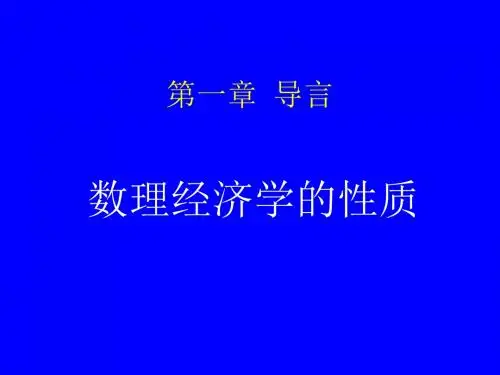
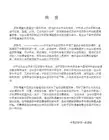
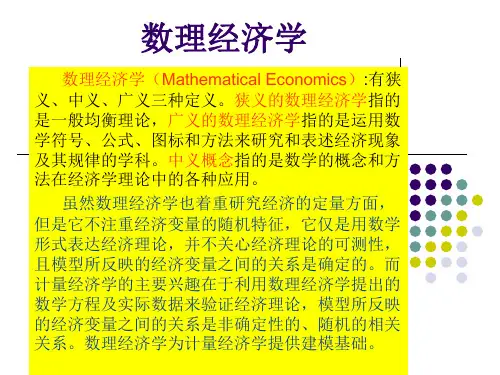
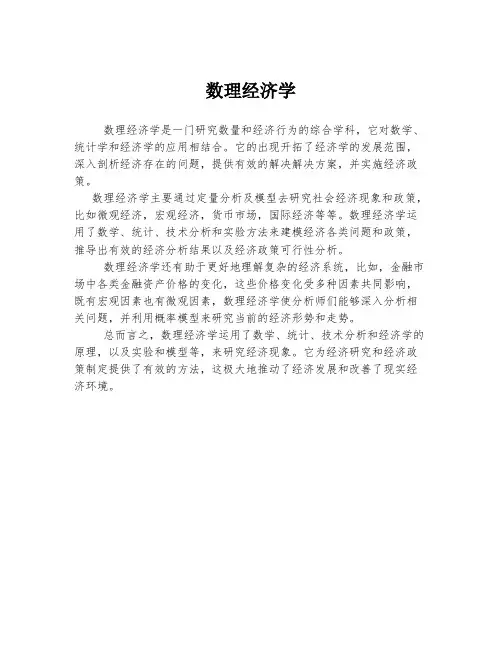
数理经济学
数理经济学是一门研究数量和经济行为的综合学科,它对数学、统计学和经济学的应用相结合。
它的出现开拓了经济学的发展范围,深入剖析经济存在的问题,提供有效的解决解决方案,并实施经济政策。
数理经济学主要通过定量分析及模型去研究社会经济现象和政策,比如微观经济,宏观经济,货币市场,国际经济等等。
数理经济学运用了数学、统计、技术分析和实验方法来建模经济各类问题和政策,推导出有效的经济分析结果以及经济政策可行性分析。
数理经济学还有助于更好地理解复杂的经济系统,比如,金融市场中各类金融资产价格的变化,这些价格变化受多种因素共同影响,既有宏观因素也有微观因素,数理经济学使分析师们能够深入分析相关问题,并利用概率模型来研究当前的经济形势和走势。
总而言之,数理经济学运用了数学、统计、技术分析和经济学的原理,以及实验和模型等,来研究经济现象。
它为经济研究和经济政策制定提供了有效的方法,这极大地推动了经济发展和改善了现实经济环境。